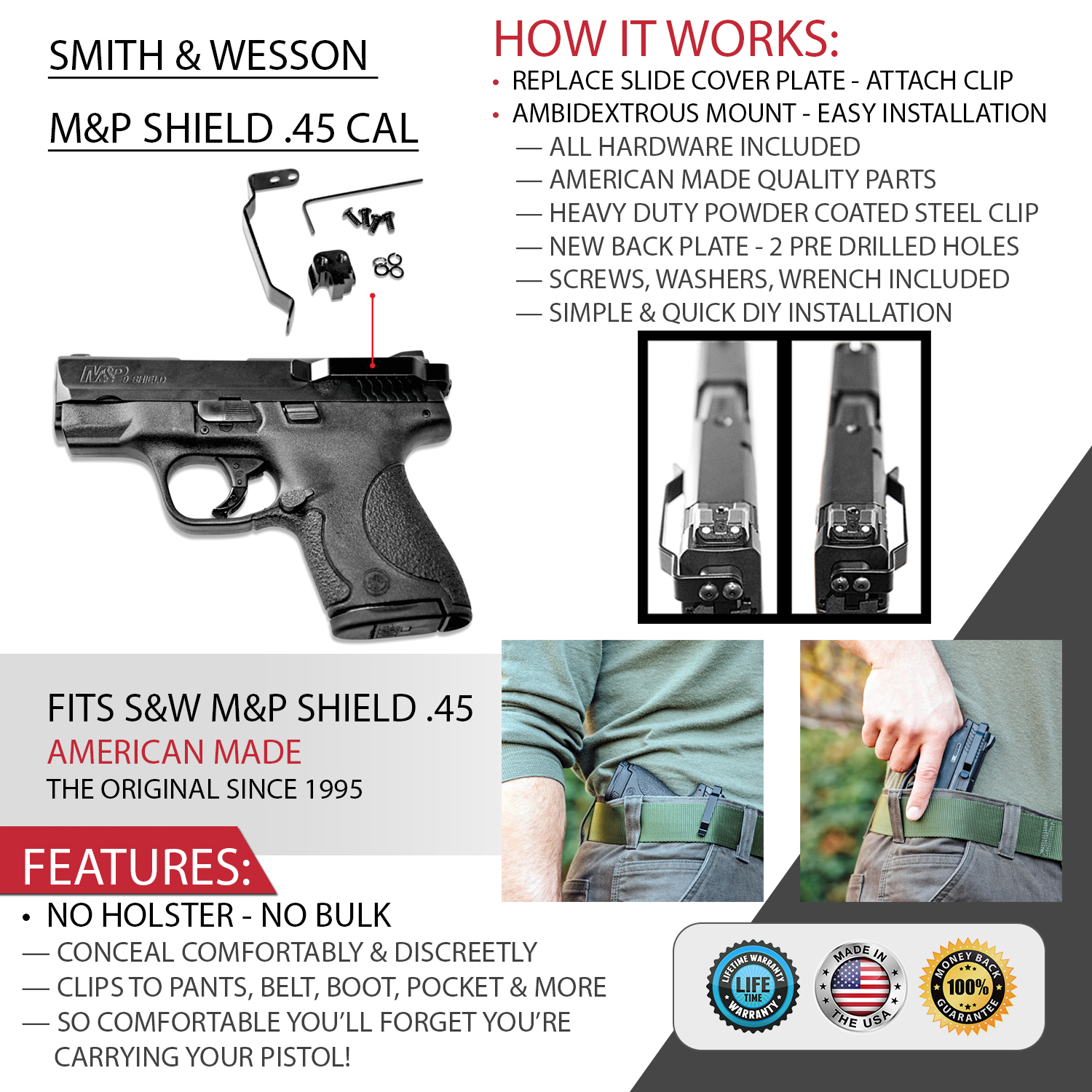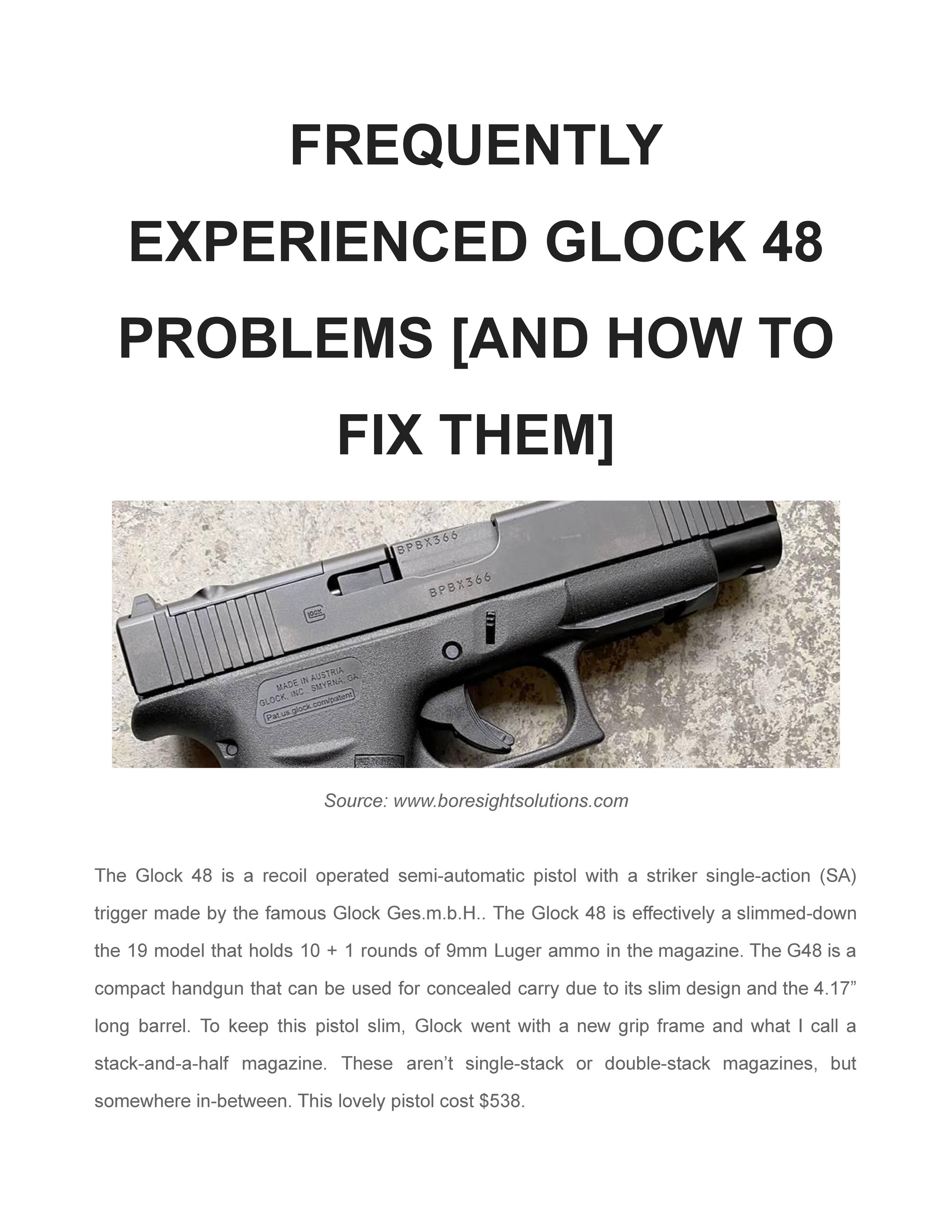Glock Nomenclature - Glocks are semi-automatic pistols with polymer frames. They are chambered in a variety of calibers, and are designed and manufactured in Austria (with some manufacturing plants in the US as well).
The Glock 17 appeared in the early 1980s for weapons testing by the Austrian military. It entered service under the designation P80. In 1988, it entered service with the Swedish army under the designation Pistol 88. It is also used by the Norwegian army and police. The 17 designation derives from the pistol being Gaston Glock's 17th patent, rather than its magazine capacity.
Glock Nomenclature

Various models of the Glock (G22) are also used by some US military units, and a large portion of US law enforcement also use Glocks (primarily in 9mm, .40 S&W, .45 ACP, and .357 SIG).
Partial Price, Full Conceal
The Glock line of pistols has been redesigned several times throughout its lifespan and has proven to be extremely reliable.
Glock pistols are striker-fired, short recoil, and locked breech. Glock uses what Glock calls a "safe action"; a safety system built into the gun itself to prevent accidental discharges. These include the trigger safety (a lever built into the trigger itself that prevents the trigger from being pulled unless the lever is pulled first), the firing pin safety (a pin attached to the trigger assembly by an extension bar, which locks the punch striker). the cartridge trigger until it is pulled) and a drop safety (the end of the extension bar locks the firing pin from behind until the trigger is pulled).
The safe action does not interfere with the normal operation of the weapon; if the trigger is pulled, the gun will fire.
Glock has updated its basic design several times throughout its production history. Commentators have long distinguished major shifts in generations. Glock finally adopted this nomenclature with their "Gen4" models.
Compact Edc Hyper Fast 8.75x12 Mouse Pad For Gaming, Office & Home Or
Glock "Gen 1" are the original models, produced between 1982 and 1991. These models had a smooth grip and a very dark black frame. Later models would lighten the color of the black polymer frame. In total, only 115,000 17, 18 and 19 year Glock models were produced. As a result, they are hard to find today and while they are hot collectibles, they are still the most expensive of all generations.
Mid-life upgrades to Glock pistols added checkers to the front strap and buckles to the rear strap. These versions were introduced in 1988 and were known informally as "second generation" models. To comply with US ATF regulations, a steel plate stamped with the serial number was inserted in front of the receiver trigger.
In 1991, an integrated return spring assembly replaced the original two-piece spring and tube design. The charger was slightly modified by changing the floor plate and adding a resistance insert to the spring follower at the base.

Being more common than Gen 1, Gen 2 Glocks are popular but less desirable to collectors.
Big 9mm Shootout: Glock, Cz, Fn, And Springfield Compete
In the late 1990s, the frame was modified with an accessory rail (called the "universal Glock rail") to mount laser sights, tactical lights, and other accessories. Added finger supports on both sides of the frame and in the finger slots on the front strap. Glock pistols with these versions are informally (initially) referred to as "third generation" models. Later third generation models also featured a modified extractor that serves as a loaded chamber indicator, and the locking block was enlarged by adding an additional cross pin to help distribute the forces exerted by the locking block. This cross pin is known as the locking pin and is located at the top of the trigger.
The polymer frames of the third generation models can be black, flat dark earth or olive. In addition, non-firing dummy pistols ("R" models) have a bright red frame and mock practice guns ("T" models) have a bright blue frame for easy identification.
In 2009, the Glock 22 RTF2 (Rough Textured Frame 2) (chambered in .40 S&W) was introduced. This pistol had a new checkered texture around the grip and new rifling grooves (like fish gills) on the rear of the sides of the slide. Many existing models were available in the RTF2 version, including the 31, 32, 23, 21, 19. Some of them did not have a fishbowl.
Millions of Glock Gen 3s have been produced, and are the most common of all Glock generations.
Best Glocks Of 2023
Many models come in the 4th generation version. Most of the others are 3rd generation versions. The "Gen 4" versions have some notable differences. The main differences are the presence of interchangeable backstraps (to make the right hand thicker or thinner for shooters with different sized hands) and a reversible magazine release to change the magazine release so that left-handed shooters can eject more easily. the magazine
4. Gen 4 Glocks received mixed reactions, with most criticism directed at the rough grip and modified spring, which led to recalls.
Glock Gen 5 pistols do not have finger slots, but allow backstrap customization like the Gen 4 and have ambidextrous slides. The slide edges are bevelled, which was previously the case on the Glock 34. Current production Gen 5 guns have front serrations.

The Glock 17 (G17) is a full-size 9mm variant and is the first Glock model produced, so named because it was Glock's 17th patent. It has a 4.5 inch/10.1 cm barrel and a standard magazine capacity of 17 rounds.
Wilson Combat Vickers Elite G17 Gen5 Pistol Glk Veg5 17
The Glock 17C (for "compensated") has a barrel and slide to reduce muzzle rise while firing the weapon. Although a production Glock, it cannot be used in the Production Division in USPSA or IDPA matches.
The Glock 17L is a competition version with a longer barrel and slide. Early versions also had a (compensated) barrel to combat muzzle flip. The 17L has been largely superseded by the Glock 34 due to subsequent reductions in overall longevity in many popular competition categories. NOT LEGAL for the PRODUCTION DIVISION in USPSA or IDPA competition because it does not fit in the "IDPA BOX" due to its length.
Usually GLOCK does this every few years for 3 or 4 years. It no longer fills a niche market, but is highly desirable due to its better sight radius and low flip for weight, as well as higher velocity due to the longer barrel.
The Glock 17A is a variant produced for the Australian market to comply with local barrel length laws. The only difference between a Glock 17 and a Glock 17A is that the 17A has a long 120mm barrel that protrudes significantly from the frame and the magazine only holds 10 rounds.
First English Review Of The Glock Pistol, October 1984 Sof Article Plus A Few More Extra Articles.
The Glock 17Pro is a special version produced exclusively for the Finnish market. Improvements over the standard Glock 17 include:
A redacted version used by the FBI. The Glock 17 is very similar to the Gen 5, with the exception of several quirks, including an extended magazine release, a neater magazine, and nDLC coated internals.
The GLOCK 18 (G18) is a full-size 9mm variant of the Glock; however, unlike all other Glock models, it is a selective fire submachine gun and has a sliding selector. Select fire parts are not interchangeable with any other Glock variant. This variant can hold Glock 17 magazines or 33 round magazines.
Compact variant of 9 mm. It has a 4-inch barrel and a standard magazine capacity of 15 rounds. The Glock 19 can take Glock 17 and Glock 18 magazines (33 rounds).
Just Joined With A Glock 19!
Full size 10mm variant. The frame of this Glock (and the Glock 21) is slightly larger than other Glocks to accommodate the size and power of the cartridges fired. The Glock 20 has a standard 15-round magazine and a 4.5-inch barrel.
It is one of the few pistols chambered for the 10mm cartridge and has a 6" barrel available for purchase.
Full size .45 ACP variant. Like the Glock 20, the frame of this pistol is larger to accommodate the size and power of the cartridge fired. The Glock 21 has a 4.5-inch barrel and a standard magazine capacity of 13 rounds.
A variant of the SF version, sometimes informally known as the 21SFP, included a standard Picatinny rail instead of the Glock rail, as well as an ambidextrous magazine. This variant was manufactured for a specific customer.
Glock Downloadable Materials
Full size .40 S&W variant. It has a 4.5-inch barrel and a standard magazine capacity of 15 rounds. It has the same overall size as the Glock 17.
.40 S&W compact variant. It has a 4-inch barrel and a standard magazine capacity of 13 rounds. The Glock 23, like the Glock 19, can use full-size variant magazines (in this case, the Glock 22).
This is a competition variant of the Glock 22. It has similar features to the Glock 17L and, like the Glock 17L, was withdrawn from regular production when the Glock 34 and 35 were released.

This is a compact .380 ACP variant adapted from the Glock 19. Unlike other Glocks,
Best Glock Types
Antibody nomenclature, lennox nomenclature, montessori nomenclature, nomenclature iupac, nomenclature perfume, pharmaceutical nomenclature, nomenclature, trane nomenclature, glock nomenclature diagram, nomenclature fragrance, goodman nomenclature, nomenclature cards
0 Comments